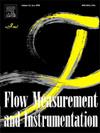Void fraction measurement of gas-liquid two-phase flow based on a multi-frequency CCEIT system
IF 2.3
3区 工程技术
Q2 ENGINEERING, MECHANICAL
引用次数: 0
Abstract
This work proposes a novel void fraction measurement method of the gas-liquid two-phase flow based on a multi-frequency capacitively coupled electrical impedance tomography (MFCCEIT) system. The proposed method fully leverages the multi-frequency data of the fluid impedance by integrating the statistical and frequency features of the impedance spectroscopy. An innovative feature extraction approach is presented. It combines statistical feature analysis and impedance spectroscopy analysis to develop a hybrid feature vector consisting of both the statistical features and frequency features of the multi-frequency impedance data that are closely correlated with the void fraction. Firstly, data preprocessing steps including electrode pair grouping and frequency range segmentation are employed. Subsequently, the statistical and frequency characteristics of the multi-frequency impedance data are investigated. Correspondingly, a hybrid feature vector consisting of the average standard deviations of the impedance across multiple frequencies and the impedance spectroscopy fitting parameters is established for each flow pattern. Comparison study is conducted to seek the best fit data mining algorithm for the hybrid features, and the original void fraction measurement method combining the proposed feature extraction approach and the Gaussian Process Regression (GPR) algorithm is obtained to develop accurate void fraction measurement models. Experimental results show the effectiveness and potential of the proposed method. Under bubble flow, annular flow and stratified flow, the maximum absolute errors of the void fraction measurement method are 1.79 %, 1.91 % and 1.61 %, respectively, and the root mean squared errors (RMSEs) are 0.0046, 0.0064 and 0.0053, respectively. The research results also show that the proposed method outperforms the traditional single-frequency methods, highlighting the contributions of the multi-frequency measurement acquisition and the feature extraction approach in fully mining and utilizing the fluid impedance information.
求助全文
约1分钟内获得全文
求助全文
来源期刊

Flow Measurement and Instrumentation
工程技术-工程:机械
CiteScore
4.30
自引率
13.60%
发文量
123
审稿时长
6 months
期刊介绍:
Flow Measurement and Instrumentation is dedicated to disseminating the latest research results on all aspects of flow measurement, in both closed conduits and open channels. The design of flow measurement systems involves a wide variety of multidisciplinary activities including modelling the flow sensor, the fluid flow and the sensor/fluid interactions through the use of computation techniques; the development of advanced transducer systems and their associated signal processing and the laboratory and field assessment of the overall system under ideal and disturbed conditions.
FMI is the essential forum for critical information exchange, and contributions are particularly encouraged in the following areas of interest:
Modelling: the application of mathematical and computational modelling to the interaction of fluid dynamics with flowmeters, including flowmeter behaviour, improved flowmeter design and installation problems. Application of CAD/CAE techniques to flowmeter modelling are eligible.
Design and development: the detailed design of the flowmeter head and/or signal processing aspects of novel flowmeters. Emphasis is given to papers identifying new sensor configurations, multisensor flow measurement systems, non-intrusive flow metering techniques and the application of microelectronic techniques in smart or intelligent systems.
Calibration techniques: including descriptions of new or existing calibration facilities and techniques, calibration data from different flowmeter types, and calibration intercomparison data from different laboratories.
Installation effect data: dealing with the effects of non-ideal flow conditions on flowmeters. Papers combining a theoretical understanding of flowmeter behaviour with experimental work are particularly welcome.
 求助内容:
求助内容: 应助结果提醒方式:
应助结果提醒方式:


